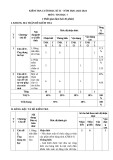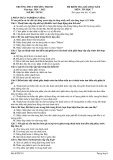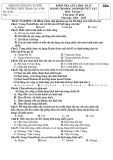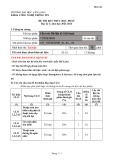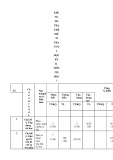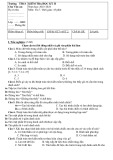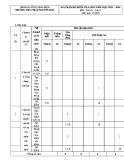1
Ngôn ngữ lập trình C++
Chương 4 – Mảng
Chương 4. © 2004 Trần Minh Châu. FOTECH. VNU
2
Chương 4 – Mảng
Đề mục 4.1 4.2 4.3 4.4 4.5 4.6 4.7 4.8 4.9
Giới thiệu Mảng Khai báo mảng Ví dụ về sử dụng mảng Truyền tham số cho hàm Sắp xếp mảng Ví dụ: Dùng mảng tính Mean, Median và Mode Tìm kiếm trên mảng: Tìm kiếm Tuyến tính và tìm kiếm Nhị phân Mảng nhiều chiều
Chương 4. © 2004 Trần Minh Châu. FOTECH. VNU
3
4.1 Giới thiệu
• Mảng (array)
– Cấu trúc của những phần tử dữ liệu có liên quan – Thực thể tĩnh (giữ nguyên kích thước trong suốt chương
trình)
• Một vài loại mảng
– mảng dựa vào con trỏ (Pointer-based arrays) (C-like) – mảng là đối tượng (Arrays as objects) (C++)
Chương 4. © 2004 Trần Minh Châu. FOTECH. VNU
4
4.2 Mảng
• Mảng
– Tập hợp các vùng nhớ liên tiếp – Cùng tên, cùng kiểu (int, char, ...)
• Truy nhập đến 1 phần tử
– Chỉ ra tên mảng và vị trí - position (chỉ số - index) – Cú pháp: tên_mảng[ chỉ_số ] – Phần tử đầu tiên ở vị trí 0
• Mảng c có n phần tử
c[ 0 ], c[ 1 ] … c[ n - 1 ]
– Phần tử thứ N ở vị trí thứ N-1
Chương 4. © 2004 Trần Minh Châu. FOTECH. VNU
5
4.2 Mảng
• Phần tử của mảng cũng như các biến khác
– Gán giá trị và in mảng số nguyên c
c[ 0 ] = 3; cout << c[ 0 ];
• Có thể sử dụng các phép toán trong cặp ngoặc vuông
c[ 5 – 2 ] cũng giống c[3]
Chương 4. © 2004 Trần Minh Châu. FOTECH. VNU
Tên mảng (Lưu ý rằng mọi phần tử của mảng này đều có cùng tên, c)
6
c[0]
-45
c[1]
6
c[2]
0
c[3]
72
c[4]
1543
c[5]
-89
c[6]
0
c[7]
62
c[8]
-3
c[9]
1
c[10]
6453
c[11]
78
Chỉ số của phần tử trong mảng c
Chương 4. © 2004 Trần Minh Châu. FOTECH. VNU
7
4.3 Khai báo mảng
• Khi khai báo mảng, chỉ rõ
– Tên – Kiểu của mảng
• Bất cứ kiểu dữ liệu nào
– Số phần tử – type arrayName[ arraySize ];
int c[ 10 ]; // mảng của 10 số nguyên float d[ 3284 ]; // mảng của 3284 số thực
• Khai báo nhiều mảng cùng kiểu
– Sử dụng dấu phẩy như với các biến bình thường int b[ 100 ], x[ 27 ];
Chương 4. © 2004 Trần Minh Châu. FOTECH. VNU
8
4.4 Ví dụ về sử dụng mảng
• Khởi tạo mảng
– Dùng vòng lặp khởi tạo từng phần tử – Khởi tạo cả danh sách
• Chỉ rõ từng phần tử khi khai báo mảng int n[ 5 ] = { 1, 2, 3, 4, 5 }; • Nếu trong danh sách không có đủ số giá trị khởi tạo, các phần tử ở
bên phải nhất sẽ nhận giá trị 0
• Nếu danh sách thừa sẽ gây lỗi cú pháp – Khởi tạo giá trị bằng 0 cho tất cả các phần tử
int n[ 5 ] = { 0 };
– Nếu không khai báo kích thước mảng, kích thước của danh sách
các giá trị khởi tạo sẽ quyết định kích thước mảng int n[] = { 1, 2, 3, 4, 5 }; • Có 5 giá trị khởi tạo, do đó mảng có 5 phần tử • Nếu không khai báo kích thước mảng thì phải khởi tạo khi khai báo
Chương 4. © 2004 Trần Minh Châu. FOTECH. VNU
9
fig04_03.cpp (1 of 2)
Khai báo mảng 10 phần tử số nguyên.
Khởi tạo mảng bằng vòng lặp for. Chú ý rằng mảng gồm các phẩn tử từ n[0] đến n[9].
1 // Fig. 4.3: fig04_03.cpp
2 // Initializing an array.
3 #include
15 16 17 18 // initialize elements of array n to 0 for ( int i = 0; i < 10; i++ ) n[ i ] = 0; // set element at location i to 0
19 20 cout << "Element" << setw( 13 ) << "Value" << endl;
21 22 23 24 // output contents of array n in tabular format for ( int j = 0; j < 10; j++ ) cout << setw( 7 ) << j << setw( 13 ) << n[ j ] << endl;
©2004 Trần Minh Châu. FOTECH. VNU.
25
10 26 return 0; // indicates successful termination
27 28 } // end main
fig04_03.cpp (2 of 2)
fig04_03.cpp output (1 of 1)
Element Value 0 0 1 0 2 0 3 0 4 0 5 0 6 0 7 0 8 0 9 0
©2004 Trần Minh Châu. FOTECH. VNU.
11
fig04_04.cpp (1 of 1)
Lưu ý cách dùng danh sách khởi tạo cho mảng.
// use initializer list to initialize array n int n[ 10 ] = { 32, 27, 64, 18, 95, 14, 90, 70, 60, 37 };
1 // Fig. 4.4: fig04_04.cpp
2 // Initializing an array with a declaration.
3 #include
// output contents of array n in tabular format for ( int i = 0; i < 10; i++ )
18 19 20 21 cout << setw( 7 ) << i << setw( 13 ) << n[ i ] << endl;
22 23 return 0; // indicates successful termination
©2004 Trần Minh Châu. FOTECH. VNU.
24 25 } // end main
12
fig04_04.cpp output (1 of 1)
Element Value 0 32 1 27 2 64 3 18 4 95 5 14 6 90 7 70 8 60 9 37
©2004 Trần Minh Châu. FOTECH. VNU.
13
4.4
Ví dụ về sử dụng mảng
• Kích thước của mảng
– Có thể được xác định bằng hằng số (const)
• const int size = 20;
– Hằng số không thể thay đổi – Hằng phải được khởi tạo khi khai báo – Còn được gọi là “named constant” (giá trị được đặt tên) hoặc
“read-only variable” (biến chỉ đọc)
Chương 4. © 2004 Trần Minh Châu. FOTECH. VNU
14
fig04_05.cpp (1 of 2)
Chú ý từ khoá const. Chỉ có các biến const được dùng để khai báo kích thước mảng.
// constant variable can be used to specify array size const int arraySize = 10;
1 // Fig. 4.5: fig04_05.cpp
2 // Initialize array s to the even integers from 2 to 20.
3 #include
18 19 20 for ( int i = 0; i < arraySize; i++ ) // set the values s[ i ] = 2 + 2 * i;
21 22 cout << "Element" << setw( 13 ) << "Value" << endl;
Chương trình dễ thay đổi hơn khi ta dùng hằng (const) cho kích thước của mảng. Ta có thể thay đổi arraySize, và tất cả các vòng lặp vẫn hoạt động bình thường (nếu không, ta phải sửa mọi vòng lặp trong chương trình).
©2004 Trần Minh Châu. FOTECH. VNU.
23
15
// output contents of array s in tabular format for ( int j = 0; j < arraySize; j++ )
24 25 26 cout << setw( 7 ) << j << setw( 13 ) << s[ j ] << endl;
fig04_05.cpp (2 of 2)
27 28 return 0; // indicates successful termination
29 30 } // end main
fig04_05.cpp output (1 of 1)
©2004 Trần Minh Châu. FOTECH. VNU.
Element Value 0 2 1 4 2 6 3 8 4 10 5 12 6 14 7 16 8 18 9 20
16
fig04_06.cpp (1 of 1)
Khởi tạo hằng
fig04_06.cpp output (1 of 1)
int main()
1 // Fig. 4.6: fig04_06.cpp
2 // Using a properly initialized constant variable.
3 #include
cout << "The value of constant variable x is: "
11 12 13 << x << endl;
14 15 return 0; // indicates successful termination
16 17 } // end main
©2004 Trần Minh Châu. FOTECH. VNU.
The value of constant variable x is: 7
17
Lỗi cú pháp do không khởi tạo hằng. Sửa giá trị của hằng cũng là một lỗi.
int main()
fig04_07.cpp (1 of 1)
1 // Fig. 4.7: fig04_07.cpp 2 // A const object must be initialized. 3 4 5 { 6 const int x; // Error: x must be initialized
fig04_07.cpp output (1 of 1)
7 8 x = 7; // Error: cannot modify a const variable
9 10 return 0; // indicates successful termination
11 12 } // end main
d:\cpphtp4_examples\ch04\Fig04_07.cpp(6) : error C2734: 'x' :
const object must be initialized if not extern
d:\cpphtp4_examples\ch04\Fig04_07.cpp(8) : error C2166:
©2004 Trần Minh Châu. FOTECH. VNU.
l-value specifies const object
18
fig04_08.cpp (1 of 1)
fig04_08.cpp output (1 of 1)
1 // Fig. 4.8: fig04_08.cpp
2 // Compute the sum of the elements of the array.
3 #include
11 12 int a[ arraySize ] = { 1, 2, 3, 4, 5, 6, 7, 8, 9, 10 };
13 14 int total = 0;
// sum contents of array a for ( int i = 0; i < arraySize; i++ ) total += a[ i ];
15 16 17 18 19 20 cout << "Total of array element values is " << total << endl;
21 22 return 0; // indicates successful termination
23 24 } // end main
Total of array element values is 55
©2004 Trần Minh Châu. FOTECH. VNU.
19
fig04_09.cpp (1 of 2)
Element Value Histogram
0 19 ******************* 1 3 *** 2 15 *************** 3 7 ******* 4 11 *********** 5 9 ********* 6 13 ************* 7 5 ***** 8 17 ***************** 9 1 *
1 // Fig. 4.9: fig04_09.cpp
2 // Histogram printing program.
3 #include
16 17 18 cout << "Element" << setw( 13 ) << "Value" << setw( 17 ) << "Histogram" << endl;
©2004 Trần Minh Châu. FOTECH. VNU.
19
20
20 21 22 23 // for each element of array n, output a bar in histogram for ( int i = 0; i < arraySize; i++ ) { cout << setw( 7 ) << i << setw( 13 ) << n[ i ] << setw( 9 );
In số dấu sao (*) tương ứng fig04_09.cpp với giá trị của phần tử n[i]. (2 of 2)
24 25 26 for ( int j = 0; j < n[ i ]; j++ ) // print one bar cout << '*';
fig04_09.cpp output (1 of 1)
27 28 cout << endl; // start next line of output
29 30 } // end outer for structure
31 32 return 0; // indicates successful termination
33 34 } // end main Element Value Histogram
©2004 Trần Minh Châu. FOTECH. VNU.
0 19 ******************* 1 3 *** 2 15 *************** 3 7 ******* 4 11 *********** 5 9 ********* 6 13 ************* 7 5 ***** 8 17 ***************** 9 1 *
21
fig04_10.cpp (1 of 2)
Viết lại một chương trình cũ. Một mảng được sử dụng thay cho 6 biến thường, và các phần tử dễ dàng cập nhật hơn (không cần sử dụng switch).
1 // Fig. 4.10: fig04_10.cpp
2 // Roll a six-sided die 6000 times.
3 #include
19 20 srand( time( 0 ) ); // seed random-number generator
Dòng lệnh này tạo ra một số trong khoảng 1 đến 6 và tăng phần tử frequency[] có chỉ số đó.
// roll die 6000 times for ( int roll = 1; roll <= 6000; roll++ )
©2004 Trần Minh Châu. FOTECH. VNU.
21 22 23 24 25 ++frequency[ 1 + rand() % 6 ]; // replaces 20-line switch // of Fig. 3.8
22
26 27 cout << "Face" << setw( 13 ) << "Frequency" << endl;
fig04_10.cpp (2 of 2)
// output frequency elements 1-6 in tabular format for ( int face = 1; face < arraySize; face++ )
cout << setw( 4 ) << face
28 29 30 31 32 << setw( 13 ) << frequency[ face ] << endl;
fig04_10.cpp output (1 of 1)
33 34 return 0; // indicates successful termination
35 36 } // end main
©2004 Trần Minh Châu. FOTECH. VNU.
Face Frequency 1 1003 2 1004 3 999 4 980 5 1013 6 1001
23
fig04_11.cpp (1 of 2)
1 // Fig. 4.11: fig04_11.cpp ***modified***
2 // Student mark statistic program.
3 #include
// place student marks in array of marks int marks[ markSize ] = { 1, 2, 6, 4, 8, 5, 9, 7, 8,
17 18 19 20 21 10, 1, 6, 3, 8, 6, 10, 3, 8, 2, 7, 6, 5, 7, 6, 8, 6, 7, 5, 6, 6, 5, 6, 7, 5, 6, 4, 8, 6, 8, 10 };
22 23 24 // initialize frequency counters to 0 int frequency[ frequencySize ] = { 0 };
©2004 Trần Minh Châu. FOTECH. VNU.
25
24
// for each student's mark, select value of an element of array // responses and use that value as subscript in array // frequency to determine element to increment for ( int student = 0; student < markSize; student++ )
fig04_11.cpp (2 of 2)
26 27 28 29 30 ++frequency[ marks[student] ];
31 32 33 // display results cout << "Rating" << setw( 17 ) << "Frequency" << endl;
// output frequencies in tabular format for ( int rating = 1; rating < frequencySize; rating++ )
cout << setw( 6 ) << rating
34 35 36 37 38 << setw( 17 ) << frequency[ rating ] << endl;
39 40 return 0; // indicates successful termination
41 42 } // end main
marks[student] là điểm (từ 1 đến 10). Giá trị này quyết định chỉ số của phần tử frequency[] cần tăng.
©2004 Trần Minh Châu. FOTECH. VNU.
Rating Frequency 1 2 2 2 3 2 4 2 5 5 6 11 7 5 8 7 9 1 10 3
25
4.4 Ví dụ về sử dụng mảng
• Xâu - string (xem thêm ở chương 5)
– Mảng của các ký tự – Mọi xâu đều kết thúc với ký tự null ('\0') – Ví dụ
• char string1[] = "hello";
– Ký tự null tự động được thêm vào, xâu có 6 phần tử
• char string1[] = { 'h', 'e', 'l', 'l',
'o', '\0’ };
– Chỉ số cũng giống như đối với mảng
String1[ 0 ] bằng 'h' string1[ 2 ] bằng 'l'
Chương 4. © 2004 Trần Minh Châu. FOTECH. VNU
26
4.4 Ví dụ về sử dụng mảng
• Nhập từ bàn phím bằng cin char string2[ 10 ]; cin >> string2; – Ghi dữ liệu vào của người dùng vào xâu
• Dừng lại ở ký tự trắng đầu tiên (tab, newline, blank…) • Thêm vào ký tự null
– Nếu nhập quá nhiều, dữ liệu sẽ tràn mảng
• Ta cần phải tránh điều này (mục 5.12 sẽ giải thích phương
pháp)
• In xâu
– cout << string2 << endl;
• Không sử dụng được với các mảng có kiểu dữ liệu khác
– In các ký tự cho đến khi gặp null
Chương 4. © 2004 Trần Minh Châu. FOTECH. VNU
27
fig04_12.cpp (1 of 2)
Hai cách khác nhau để khai báo xâu. string2 được khởi tạo và kích thước được xác định tự động.
int main()
Ví dụ về đọc xâu từ bàn phím và in ra.
1 // Fig. 4_12: fig04_12.cpp
2 // Treating character arrays as strings.
3 #include
13 14 15 16 // read string from user into array string2 cout << "Enter the string \"hello there\": "; cin >> string1; // reads "hello" [space terminates input]
17 18 19 20 // output strings cout << "string1 is: " << string1 << "\nstring2 is: " << string2;
21 22 cout << "\nstring1 with spaces between characters is:\n";
©2004 Trần Minh Châu. FOTECH. VNU.
23
28
24 25 26 // output characters until null character is reached for ( int i = 0; string1[ i ] != '\0'; i++ ) cout << string1[ i ] << ' ';
Có thể truy nhập xâu giống fig04_12.cpp như đối với mảng. Vòng lặp (2 of 2) kết thúc khi gặp ký tự null.
27 28 29 cin >> string1; // reads "there" cout << "\nstring1 is: " << string1 << endl;
fig04_12.cpp output (1 of 1)
30 31 return 0; // indicates successful termination
32 33 } // end main
©2004 Trần Minh Châu. FOTECH. VNU.
Enter the string "hello there": hello there string1 is: hello string2 is: string literal string1 with spaces between characters is: h e l l o string1 is: there
29
4.4
Ví dụ về sử dụng mảng
• Kiểu lưu trữ tĩnh – static storage (chương 3)
– Nếu là static, các biến địa phương lưu lại giá trị giữa các
lần gọi hàm
– chỉ được nhìn thấy trong thân hàm – Có thể khai báo mảng địa phương là static
• được khởi tạo về 0 static int array[3];
• Nếu không phải static
– Được tạo (và huỷ) tại mỗi lần gọi hàm
Chương 4. © 2004 Trần Minh Châu. FOTECH. VNU
30
fig04_13.cpp (1 of 3)
1 // Fig. 4.13: fig04_13.cpp
2 // Static arrays are initialized to zero.
3 #include
16 17 18 19 20 cout << "\n\nSecond call to each function:\n"; staticArrayInit(); automaticArrayInit(); cout << endl;
21 22 return 0; // indicates successful termination
©2004 Trần Minh Châu. FOTECH. VNU.
23 24 } // end main 25
Mảng static, khởi tạo về 0 tại lần gọi hàm đầu tiên.
31
fig04_13.cpp (2 of 3)
26 // function to demonstrate a static local array 27 void staticArrayInit( void ) 28 { 29 30 // initializes elements to 0 first time function is called static int array1[ 3 ];
31 32 cout << "\nValues on entering staticArrayInit:\n";
// output contents of array1 for ( int i = 0; i < 3; i++ )
33 34 35 36 cout << "array1[" << i << "] = " << array1[ i ] << " ";
Dữ liệu trong mảng bị thay đổi, các thay đổi được bảo toàn.
37 38 cout << "\nValues on exiting staticArrayInit:\n";
// modify and output contents of array1 for ( int j = 0; j < 3; j++ )
cout << "array1[" << j << "] = "
39 40 41 42 43 << ( array1[ j ] += 5 ) << " ";
©2004 Trần Minh Châu. FOTECH. VNU.
44 45 } // end function staticArrayInit 46
Mảng automatic, được tạo lại tại mỗi lần gọi hàm.
32
fig04_13.cpp (3 of 3)
47 // function to demonstrate an automatic local array 48 void automaticArrayInit( void ) 49 { 50 51 // initializes elements each time function is called int array2[ 3 ] = { 1, 2, 3 };
52 53 cout << "\n\nValues on entering automaticArrayInit:\n";
// output contents of array2 for ( int i = 0; i < 3; i++ )
54 55 56 57 cout << "array2[" << i << "] = " << array2[ i ] << " ";
58 59 cout << "\nValues on exiting automaticArrayInit:\n";
Tuy mảng bị thay đổi, nó sẽ bị huỷ khi hàm kết thúc và thayt đổi trong dữ liệu sẽ bị mất.
// modify and output contents of array2 for ( int j = 0; j < 3; j++ )
cout << "array2[" << j << "] = "
60 61 62 63 64 << ( array2[ j ] += 5 ) << " ";
©2004 Trần Minh Châu. FOTECH. VNU.
65 66 } // end function automaticArrayInit
33 First call to each function:
fig04_13.cpp output (1 of 1)
Values on entering staticArrayInit: array1[0] = 0 array1[1] = 0 array1[2] = 0 Values on exiting staticArrayInit: array1[0] = 5 array1[1] = 5 array1[2] = 5
Values on entering automaticArrayInit: array2[0] = 1 array2[1] = 2 array2[2] = 3 Values on exiting automaticArrayInit: array2[0] = 6 array2[1] = 7 array2[2] = 8
Second call to each function:
Values on entering staticArrayInit: array1[0] = 5 array1[1] = 5 array1[2] = 5 Values on exiting staticArrayInit: array1[0] = 10 array1[1] = 10 array1[2] = 10
©2004 Trần Minh Châu. FOTECH. VNU.
Values on entering automaticArrayInit: array2[0] = 1 array2[1] = 2 array2[2] = 3 Values on exiting automaticArrayInit: array2[0] = 6 array2[1] = 7 array2[2] = 8
34
4.5 Truyền tham số cho hàm
• Dùng tên mảng, bỏ cặp ngoặc vuông
– Truyền mảng myArray cho hàm myFunction int myArray[ 24 ]; myFunction( myArray, 24 );
– Kích thước mảng thường được truyền, nhưng không nhất thiết
• Có ích khi dùng để duyệt tất cả các phần tử
• Mảng được truyền bằng tham chiếu (passed-by-reference)
– Hàm có thể thay đổi dữ liệu gốc của mảng – Tên mảng có giá trị bằng địa chỉ của phần tử đầu tiên
• Hàm biết mảng được lưu ở đâu. • Hàm có thể sửa đổi dữ liệu ghi trong mảng
• Các phần tử mảng được truyền bằng giá trị (passed-by-
value) – Như các biến thông thường – square( myArray[3] );
Chương 4. © 2004 Trần Minh Châu. FOTECH. VNU
35
4.5
Truyền tham số cho hàm
• Các hàm dùng mảng làm đối số
– Function prototype
• void modifyArray( int b[], int arraySize ); • void modifyArray( int [], int ); – Trong prototype, tên không bắt buộc
• cả hai hàm lấy đối số là một mảng số nguyên và 1 số nguyên
– Không ghi cần kích thước mảng trong cặp ngoặc
• Trình biên dịch bỏ qua
– Nếu khai báo 1 tham số là const
• đối số đó sẽ không thể bị thay đổi (chương trình dịch báo lỗi) • void doNotModify( const int [] );
Chương 4. © 2004 Trần Minh Châu. FOTECH. VNU
36
fig04_14.cpp (1 of 3)
Cú pháp cho mảng trong danh sách tham số
1 // Fig. 4.14: fig04_14.cpp
2 // Passing arrays and individual array elements to functions.
3 #include
cout << "Effects of passing entire array by reference:"
19 20 21 << "\n\nThe values of the original array are:\n";
// output original array for ( int i = 0; i < arraySize; i++ )
©2004 Trần Minh Châu. FOTECH. VNU.
22 23 24 25 cout << setw( 3 ) << a[ i ];
Truyền tên mảng (a) và kích thước cho hàm. Mảng truyền bằng tham chiếu
37 27 cout << endl;
// pass array a to modifyArray by reference modifyArray( a, arraySize );
fig04_14.cpp (2 of 3)
28 29 30 31 32 cout << "The values of the modified array are:\n";
// output modified array for ( int j = 0; j < arraySize; j++ )
33 34 35 36 cout << setw( 3 ) << a[ j ];
// output value of a[ 3 ] cout << "\n\n\n"
1 phần tử mảng được truyền bằng giá trị; giá trị phần tử gốc không thể bị thay đổi.
37 38 39 40 41 << "Effects of passing array element by value:" << "\n\nThe value of a[3] is " << a[ 3 ] << '\n';
42 43 44 // pass array element a[ 3 ] by value modifyElement( a[ 3 ] );
45 46 47 // output value of a[ 3 ] cout << "The value of a[3] is " << a[ 3 ] << endl;
48 49 return 0; // indicates successful termination
©2004 Trần Minh Châu. FOTECH. VNU.
50 51 } // end main
Tuy đặt tên là b, khi được gọi, mảng chỉ đến mảng a, nên hàm có thể thay đổi dữ liệu của a.
38
fig04_14.cpp (3 of 3)
Các phần tử đơn lẻ của mảng được truyền bằng giá trị, và các giá trị gốc không thể bị thay đổi.
©2004 Trần Minh Châu. FOTECH. VNU.
52 53 // in function modifyArray, "b" points to 54 // the original array "a" in memory 55 void modifyArray( int b[], int sizeOfArray ) 56 { 57 // multiply each array element by 2 58 for ( int k = 0; k < sizeOfArray; k++ ) 59 b[ k ] *= 2; 60 61 } // end function modifyArray 62 63 // in function modifyElement, "e" is a local copy of 64 // array element a[ 3 ] passed from main 65 void modifyElement( int e ) 66 { 67 // multiply parameter by 2 68 cout << "Value in modifyElement is " 69 << ( e *= 2 ) << endl; 70 71 } // end function modifyElement
39 Effects of passing entire array by reference:
The values of the original array are:
0 1 2 3 4
fig04_14.cpp output (1 of 1)
The values of the modified array are:
0 2 4 6 8
Effects of passing array element by value:
©2004 Trần Minh Châu. FOTECH. VNU.
The value of a[3] is 6 Value in modifyElement is 12 The value of a[3] is 6
40
fig04_15.cpp (1 of 2)
Tham số mảng được khai báo là const. Mảng không thể bị sửa đổi, kể cả khi nó được truyền bằng tham chiếu.
1 // Fig. 4.15: fig04_15.cpp
2 // Demonstrating the const type qualifier.
3 #include
13 14 tryToModifyArray( a );
15 16 cout << a[ 0 ] << ' ' << a[ 1 ] << ' ' << a[ 2 ] << '\n';
17 18 return 0; // indicates successful termination
©2004 Trần Minh Châu. FOTECH. VNU.
19 20 } // end main 21
41
fig04_15.cpp (2 of 2)
b[ 0 ] /= 2; // error b[ 1 ] /= 2; // error b[ 2 ] /= 2; // error
©2004 Trần Minh Châu. FOTECH. VNU.
22 // In function tryToModifyArray, "b" cannot be used 23 // to modify the original array "a" in main. 24 void tryToModifyArray( const int b[] ) 25 { 26 27 28 29 30 } // end function tryToModifyArray
42
4.6 Sắp xếp mảng
• Sắp xếp dữ liệu
– Là một ứng dụng quan trọng – Hầu hết mọi cơ quan/tổ chức đều phải sắp xếp dữ liệu • Một khối lượng khổng lồ dữ liệu cần được sắp xếp
• Xếp nổi bọt (Bubble sort)
– Duyệt mảng vài lần – So sánh cặp phần tử liên tiếp
• Nếu thứ tự tăng (hoặc bằng nhau), không thay đổi gì • Nếu thứ tự giảm, tráo đổi hai phần tử – Lặp lại các bước trên cho mọi phần tử
Chương 4. © 2004 Trần Minh Châu. FOTECH. VNU
43
4.6
Sắp xếp mảng
• Ví dụ:
– Đi từ trái sang phải, và tráo các phần tử khi cần thiết
• Một lần duyệt cho mỗi phần tử
3 4 2 7 6 – Dãy gốc: – Lần duyệt 1: 3 2 4 6 7 (tráo đổi phần tử) – Lần duyệt 2: 2 3 4 6 7 – Lần duyệt 3: 2 3 4 6 7 (không cần thay đổi) – Lần duyệt 4: 2 3 4 6 7 – Lần duyệt 5: 2 3 4 6 7 – Phần tử nhỏ “nổi" lên trên (như số 2 trong ví dụ)
Chương 4. © 2004 Trần Minh Châu. FOTECH. VNU
44
4.6
Sắp xếp mảng
• Tráo đổi các biến int x = 3, y = 4; y = x; x = y;
• Cái gì xảy ra?
– Cả x và y đều là 3! – Cần có biến tạm
• Giải pháp
int x = 3, y = 4, temp = 0; temp = x; // temp là 3 x = y; // x là 4 y = temp; // y là 3
Chương 4. © 2004 Trần Minh Châu. FOTECH. VNU
45
fig04_16.cpp (1 of 3)
1 // Fig. 4.16: fig04_16.cpp
2 // This program sorts an array's values into ascending order.
3 #include
17 18 cout << "Data items in original order\n";
// output original array for ( int i = 0; i < arraySize; i++ )
19 20 21 22 cout << setw( 4 ) << a[ i ];
©2004 Trần Minh Châu. FOTECH. VNU.
23
Duyệt 1 lần cho mỗi phần tử của mảng.
46
// bubble sort // loop to control number of passes for ( int pass = 0; pass < arraySize - 1; pass++ )
fig04_16.cpp (2 of 3)
// loop to control number of comparisons per pass for ( int j = 0; j < arraySize - 1; j++ )
// compare side-by-side elements and swap them if // first element is greater than second element if ( a[ j ] > a[ j + 1 ] ) { hold = a[ j ]; a[ j ] = a[ j + 1 ]; a[ j + 1 ] = hold;
Nếu phần tử bên trái (chỉ số j) lớn hơn phần tử bên phải (chỉ số j + 1), thì ta tráo đổi chúng. Nhớ sử dụng biến tạm.
24 25 26 27 28 29 30 31 32 33 34 35 36 37 38 } // end if
©2004 Trần Minh Châu. FOTECH. VNU.
39
47 40 cout << "\nData items in ascending order\n";
// output sorted array for ( int k = 0; k < arraySize; k++ )
fig04_16.cpp (3 of 3)
41 42 43 44 cout << setw( 4 ) << a[ k ];
45 46 cout << endl;
fig04_16.cpp output (1 of 1)
47 48 return 0; // indicates successful termination
49 50 } // end main
Data items in original order
2 6 4 8 10 12 89 68 45 37
Data items in ascending order
©2004 Trần Minh Châu. FOTECH. VNU.
2 4 6 8 10 12 37 45 68 89
48
4.7 Ví dụ: sử dụng mảng để tính Mean, Median và Mode
• Mean
– Giá trị trung bình (tổng/số phần tử)
• Median
– Giá trị ở giữa dãy đã được sắp xếp – 1, 2, 3, 4, 5 (3 là median) – Nếu số phần tử là số chẵn, lấy trung bình của 2 số giữa
• Mode
– Giá trị xuất hiện nhiều nhất – 1, 1, 1, 2, 3, 3, 4, 5 (1 là mode)
Chương 4. © 2004 Trần Minh Châu. FOTECH. VNU
49
fig04_17.cpp (1 of 8)
1 // Fig. 4.17: fig04_17.cpp
2 // This program introduces the topic of survey data analysis.
3 // It computes the mean, median, and mode of the data.
4 #include
©2004 Trần Minh Châu. FOTECH. VNU.
25
50 26 int frequency[ 10 ] = { 0 }; // initialize array frequency
// initialize array responses int response[ responseSize ] =
fig04_17.cpp (2 of 8)
27 28 29 30 31 32 33 34 35 36 37 38 39 { 6, 7, 8, 9, 8, 7, 8, 9, 8, 9, 7, 8, 9, 5, 9, 8, 7, 8, 7, 8, 6, 7, 8, 9, 3, 9, 8, 7, 8, 7, 7, 8, 9, 8, 9, 8, 9, 7, 8, 9, 6, 7, 8, 7, 8, 7, 9, 8, 9, 2, 7, 8, 9, 8, 9, 8, 9, 7, 5, 3, 5, 6, 7, 2, 5, 3, 9, 4, 6, 4, 7, 8, 9, 6, 8, 7, 8, 9, 7, 8, 7, 4, 4, 2, 5, 3, 8, 7, 5, 6, 4, 5, 6, 1, 6, 5, 7, 8, 7 };
40 41 42 43 44 // process responses mean( response, responseSize ); median( response, responseSize ); mode( frequency, response, responseSize );
45 46 return 0; // indicates successful termination
©2004 Trần Minh Châu. FOTECH. VNU.
47 48 } // end main 49
51
50 // calculate average of all response values 51 void mean( const int answer[], int arraySize ) 52 { 53 int total = 0;
54 55 cout << "********\n Mean\n********\n";
fig04_17.cpp (3 of 8)
// total response values for ( int i = 0; i < arraySize; i++ )
56 57 58 59 total += answer[ i ];
60 61 62 // format and output results cout << fixed << setprecision( 4 );
Đổi sang double để được giá trị trung bình bằng số thực (thay vì giá trị nguyên).
cout << "The mean is the average value of the data\n"
63 64 65 66 67 68 69 70 71 << "items. The mean is equal to the total of\n" << "all the data items divided by the number\n" << "of data items (" << arraySize << "). The mean value for\nthis run is: " << total << " / " << arraySize << " = " << static_cast< double >( total ) / arraySize << "\n\n";
©2004 Trần Minh Châu. FOTECH. VNU.
72 73 } // end function mean 74
52
cout << "\n********\n Median\n********\n"
fig04_17.cpp (4 of 8)
75 // sort array and determine median element's value 76 void median( int answer[], int size ) 77 { 78 79 << "The unsorted array of responses is";
80 81 printArray( answer, size ); // output unsorted array
Sắp xếp mảng bằng cách truyền nó cho một hàm. Bảo vệ tính modun của chương trình
82 83 bubbleSort( answer, size ); // sort array
cout << "\n\nThe sorted array is"; printArray( answer, size ); // output sorted array
// display median element cout << "\n\nThe median is element " << size / 2
84 85 86 87 88 89 90 91 92 << " of\nthe sorted " << size << " element array.\nFor this run the median is " << answer[ size / 2 ] << "\n\n";
©2004 Trần Minh Châu. FOTECH. VNU.
93 94 } // end function median 95
53
fig04_17.cpp (5 of 8)
96 // determine most frequent response 97 void mode( int freq[], int answer[], int size ) 98 { 99 100 int largest = 0; // represents largest frequency int modeValue = 0; // represents most frequent response
101 102 cout << "\n********\n Mode\n********\n";
// initialize frequencies to 0 for ( int i = 1; i <= 9; i++ )
103 104 105 106 freq[ i ] = 0;
// summarize frequencies for ( int j = 0; j < size; j++ )
107 108 109 110 ++freq[ answer[ j ] ];
// output headers for result columns cout << "Response" << setw( 11 ) << "Frequency"
111 112 113 114 115 116 << setw( 19 ) << "Histogram\n\n" << setw( 55 ) << "1 1 2 2\n" << setw( 56 ) << "5 0 5 0 5\n\n";
©2004 Trần Minh Châu. FOTECH. VNU.
117
54
// output results for ( int rating = 1; rating <= 9; rating++ ) { cout << setw( 8 ) << rating << setw( 11 )
118 119 120 121 << freq[ rating ] << " ";
fig04_17.cpp (6 of 8)
// keep track of mode value and largest fequency value if ( freq[ rating ] > largest ) { mode là giá trị xuất hiện largest = freq[ rating ]; nhiều nhất (có giá trị cao nhất modeValue = rating; trong mảng freq).
122 123 124 125 126 127 128 } // end if
// output histogram bar representing frequency value for ( int k = 1; k <= freq[ rating ]; k++ )
129 130 131 132 cout << '*';
133 134 cout << '\n'; // begin new line of output
135 136 } // end outer for
©2004 Trần Minh Châu. FOTECH. VNU.
137 138 139 140 141 // display the mode value cout << "The mode is the most frequent value.\n" << "For this run the mode is " << modeValue << " which occurred " << largest << " times." << endl;
142 143 } // end function mode
55
fig04_17.cpp (7 of 8)
144 145 // function that sorts an array with bubble sort algorithm 146 void bubbleSort( int a[], int size ) 147 { 148 int hold; // temporary location used to swap elements
149 150 151 // loop to control number of passes for ( int pass = 1; pass < size; pass++ )
152 153 154 // loop to control number of comparisons per pass for ( int j = 0; j < size - 1; j++ )
// swap elements if out of order if ( a[ j ] > a[ j + 1 ] ) {
155 156 157 158 159 160 hold = a[ j ]; a[ j ] = a[ j + 1 ]; a[ j + 1 ] = hold;
161 162 } // end if
©2004 Trần Minh Châu. FOTECH. VNU.
163 164 } // end function bubbleSort 165
56
166 // output array contents (20 values per row) 167 void printArray( const int a[], int size ) 168 { 169 for ( int i = 0; i < size; i++ ) {
fig04_17.cpp (8 of 8)
if ( i % 20 == 0 ) // begin new line every 20 values
170 171 172 cout << endl;
173 174 cout << setw( 2 ) << a[ i ];
175 176 } // end for
©2004 Trần Minh Châu. FOTECH. VNU.
177 178 } // end function printArray
57
fig04_17.cpp output (1 of 2)
******** Mean ******** The mean is the average value of the data items. The mean is equal to the total of all the data items divided by the number of data items (99). The mean value for this run is: 681 / 99 = 6.8788 ******** Median ******** The unsorted array of responses is
6 7 8 9 8 7 8 9 8 9 7 8 9 5 9 8 7 8 7 8 6 7 8 9 3 9 8 7 8 7 7 8 9 8 9 8 9 7 8 9 6 7 8 7 8 7 9 8 9 2 7 8 9 8 9 8 9 7 5 3 5 6 7 2 5 3 9 4 6 4 7 8 9 6 8 7 8 9 7 8 7 4 4 2 5 3 8 7 5 6 4 5 6 1 6 5 7 8 7
The sorted array is
1 2 2 2 3 3 3 3 4 4 4 4 4 5 5 5 5 5 5 5 5 6 6 6 6 6 6 6 6 6 7 7 7 7 7 7 7 7 7 7 7 7 7 7 7 7 7 7 7 7 7 7 7 8 8 8 8 8 8 8 8 8 8 8 8 8 8 8 8 8 8 8 8 8 8 8 8 8 8 8 9 9 9 9 9 9 9 9 9 9 9 9 9 9 9 9 9 9 9
The median is element 49 of the sorted 99 element array. For this run the median is 7
©2004 Trần Minh Châu. FOTECH. VNU.
58
******** Mode ******** Response Frequency Histogram
fig04_17.cpp output (2 of 2)
1 1 2 2 5 0 5 0 5
1 1 * 2 3 *** 3 4 **** 4 5 ***** 5 8 ******** 6 9 ********* 7 23 *********************** 8 27 *************************** 9 19 *******************
The mode is the most frequent value. For this run the mode is 8 which occurred 27 times.
©2004 Trần Minh Châu. FOTECH. VNU.
59
4.8 Tìm kiếm trên mảng: Tìm kiếm Tuyến tính và tìm kiếm Nhị phân
• Tìm một giá trị khoá (key value) trên mảng • Tìm kiếm tuyến tính
– So sánh từng phần tử của mảng với key
• Bắt đầu từ một đầu, đi đến đầu kia của mảng
– Hữu dụng cho mảng nhỏ và chưa sắp xếp
• Không hiệu quả • Nếu giá trị cần tìm không có trong mảng thì phải kiểm tra tất
cả các phần tử
Chương 4. © 2004 Trần Minh Châu. FOTECH. VNU
60
4.8
Tìm kiếm trên mảng: Tìm kiếm Tuyến
tính và tìm kiếm Nhị phân
• Tìm kiếm nhị phân
– Chỉ sử dụng cho mảng đã sắp xếp – So sánh phần tử ở giữa (middle) với key
• Nếu bằng, tìm thấy • Nếu key < middle
– Lặp lại ở nửa đầu của mảng
• Nếu key > middle
– Lặp lại ở nửa cuối
– Rất nhanh
N
• Nhiều nhất là N bước với 2 > số phần tử của mảng • mảng 30 phần tử cần nhiều nhất 5 bước
5
2 > 30
Chương 4. © 2004 Trần Minh Châu. FOTECH. VNU
61
fig04_19.cpp (1 of 2)
Lấy đối số là một mảng, khoá cần tìm, và kích thước mảng.
1 // Fig. 4.19: fig04_19.cpp
2 // Linear search of an array.
3 #include
10 11 int main() 12 { 13 14 15 const int arraySize = 100; // size of array a int a[ arraySize ]; // create array a int searchKey; // value to locate in a
for ( int i = 0; i < arraySize; i++ ) // create some data
16 17 18 a[ i ] = 2 * i;
19 20 21 cout << "Enter integer search key: "; cin >> searchKey;
22 23 24 // attempt to locate searchKey in array a int element = linearSearch( a, searchKey, arraySize );
©2004 Trần Minh Châu. FOTECH. VNU.
25
62
// display results if ( element != -1 )
cout << "Found value in element " << element << endl;
else
fig04_19.cpp (2 of 2)
26 27 28 29 30 cout << "Value not found" << endl;
Enter integer search key: 36 Found value in element 18
31 32 return 0; // indicates successful termination
Enter integer search key: 37 Value not found
if ( array[ j ] == key ) // if found, return j; // return location of key
return -1; // key not found
©2004 Trần Minh Châu. FOTECH. VNU.
33 34 } // end main 35 36 // compare key to every element of array until location is 37 // found or until end of array is reached; return subscript of 38 // element if key or -1 if key not found 39 int linearSearch( const int array[], int key, int sizeOfArray ) 40 { 41 for ( int j = 0; j < sizeOfArray; j++ ) 42 43 44 45 46 47 48 } // end function linearSearch
63
fig04_20.cpp (1 of 6)
1 // Fig. 4.20: fig04_20.cpp
2 // Binary search of an array.
3 #include
for ( int i = 0; i < arraySize; i++ ) // create some data
©2004 Trần Minh Châu. FOTECH. VNU.
23 24 25 a[ i ] = 2 * i;
26
64
27 28 cout << "Enter a number between 0 and 28: "; cin >> key;
29 30 printHeader( arraySize );
fig04_20.cpp (2 of 6)
// search for key in array a int result =
31 32 33 34 binarySearch( a, key, 0, arraySize - 1, arraySize );
// display results if ( result != -1 )
cout << '\n' << key << " found in array element "
<< result << endl;
else
35 36 37 38 39 40 41 cout << '\n' << key << " not found" << endl;
42 43 return 0; // indicates successful termination
©2004 Trần Minh Châu. FOTECH. VNU.
44 45 } // end main 46
65
int high, int size )
fig04_20.cpp (3 of 6)
47 // function to perform binary search of an array 48 int binarySearch( const int b[], int searchKey, int low, 49 50 { 51 int middle;
52 53 54 // loop until low subscript is greater than high subscript while ( low <= high ) {
55 56 57
Xác định phần tử ở giữa // determine middle element of subarray being searched middle = ( low + high ) / 2;
58 59 60 // display subarray used in this loop iteration printRow( b, low, middle, high, size );
©2004 Trần Minh Châu. FOTECH. VNU.
61
66
// if searchKey matches middle element, return middle if ( searchKey == b[ middle ] ) // match
62 63 64 return middle;
Sử dụng tìm Nhị phân: fig04_20.cpp Nếu key bằng middle, tìm thấy (4 of 6)
Nếu nhỏ hơn, tìm nửa thấp
Nếu lớn hơn, tìm nửa cao
65 66 else
// if searchKey less than middle element, // set new high element if ( searchKey < b[ middle ] )
67 68 69 70 71 high = middle - 1; // search low end of array
Vòng lặp tạo low, middle và high tự động. Nếu tìm nửa cao, thì phần tử low mới sẽ cao hơn middle.
// if searchKey greater than middle element, // set new low element else
low = middle + 1; // search high end of array
72 73 74 75 76 77 }
78 79 return -1; // searchKey not found
©2004 Trần Minh Châu. FOTECH. VNU.
80 81 } // end function binarySearch
67
fig04_20.cpp (5 of 6)
82 83 // print header for output 84 void printHeader( int size ) 85 { 86 cout << "\nSubscripts:\n";
// output column heads for ( int j = 0; j < size; j++ )
87 88 89 90 cout << setw( 3 ) << j << ' ';
91 92 cout << '\n'; // start new line of output
// output line of - characters for ( int k = 1; k <= 4 * size; k++ )
93 94 95 96 cout << '-';
97 98 cout << endl; // start new line of output
©2004 Trần Minh Châu. FOTECH. VNU.
99 100 } // end function printHeader 101
68
int high, int size )
fig04_20.cpp (6 of 6)
102 // print one row of output showing the current 103 // part of the array being processed 104 void printRow( const int b[], int low, int mid, 105 106 { 107 108 // loop through entire array for ( int m = 0; m < size; m++ )
// display spaces if outside current subarray range if ( m < low || m > high )
109 110 111 112 cout << " ";
113 114 115 // display middle element marked with a * else
if ( m == mid ) // mark middle value
116 117 118 cout << setw( 3 ) << b[ m ] << '*';
// display other elements in subarray else
119 120 121 122 cout << setw( 3 ) << b[ m ] << ' ';
123 124 cout << endl; // start new line of output
©2004 Trần Minh Châu. FOTECH. VNU.
125 126 } // end function printRow
69
Enter a number between 0 and 28: 6
Subscripts:
fig04_20.cpp output (1 of 2)
0 1 2 3 4 5 6 7 8 9 10 11 12 13 14 ------------------------------------------------------------ 0 2 4 6 8 10 12 14* 16 18 20 22 24 26 28 0 2 4 6* 8 10 12
6 found in array element 3
Enter a number between 0 and 28: 25
Subscripts:
0 1 2 3 4 5 6 7 8 9 10 11 12 13 14 ------------------------------------------------------------ 0 2 4 6 8 10 12 14* 16 18 20 22 24 26 28 16 18 20 22* 24 26 28 24 26* 28 24*
©2004 Trần Minh Châu. FOTECH. VNU.
25 not found
70 Enter a number between 0 and 28: 8
Subscripts:
fig04_20.cpp output (2 of 2)
0 1 2 3 4 5 6 7 8 9 10 11 12 13 14 ------------------------------------------------------------ 0 2 4 6 8 10 12 14* 16 18 20 22 24 26 28 0 2 4 6* 8 10 12 8 10* 12 8*
©2004 Trần Minh Châu. FOTECH. VNU.
8 found in array element 4
71
4.9 Mảng nhiều chiều
• Đa chỉ số
– int a[ 3 ][ 4 ]; – a[ i ][ j ] – Các bảng có dòng và cột – Dòng trước, cột sau – “Mảng của mảng”
• a[0] là một mảng 4 phần tử • a[0][0] là phần tử đầu tiên của mảng
Column 0 a[ 0 ][ 0 ]
Column 1 a[ 0 ][ 1 ]
Column 2 a[ 0 ][ 2 ]
Column 3 a[ 0 ][ 3 ]
Row 0
a[ 1 ][ 0 ]
a[ 1 ][ 1 ]
a[ 1 ][ 2 ]
a[ 1 ][ 3 ]
Row 1
a[ 2 ][ 0 ]
a[ 2 ][ 1 ]
a[ 2 ][ 2 ]
a[ 2 ][ 3 ]
Row 2
Column subscript (chỉ số cột)
Array name
Row subscript (chỉ số dòng)
Chương 4. © 2004 Trần Minh Châu. FOTECH. VNU
72
4.9 Mảng nhiều chiều
• Khởi tạo
1 2
– Mặc định là 0 – Khởi tạo, mỗi dòng trong 1 cặp ngoặc int b[ 2 ][ 2 ] = { { 1, 2 }, { 3, 4 } };
3 4
Row 0
Row 1
1 0
3 4
int b[ 2 ][ 2 ] = { { 1 }, { 3, 4 } };
Chương 4. © 2004 Trần Minh Châu. FOTECH. VNU
73
4.9 Mảng nhiều chiều
• Truy nhập đến như bình thường
cout << b[ 0 ][ 1 ];
1 0
– In ra 0 – Không sử dụng dấu phẩy (,)
3 4
cout << b[ 0, 1 ];
• Lỗi cú pháp • Function prototype
– Phải chỉ rõ kích thước của các chỉ số
• Không đòi hỏi kích thước cho chỉ số đầu tiên, cũng như mảng
1 chiều
– void printArray( int [][ 3 ] );
Chương 4. © 2004 Trần Minh Châu. FOTECH. VNU
Chú ý cấu trúc của prototype.
74
fig04_22.cpp (1 of 2)
Chú ý nhiều cách khởi tạo. Các phần tử trong array2 được gán từ dòng thứ nhất rồi đến dòng thứ hai.
1 // Fig. 4.22: fig04_22.cpp
2 // Initializing multidimensional arrays.
3 #include
15 16 17 cout << "Values in array1 by row are:" << endl; printArray( array1 );
18 19 20 cout << "Values in array2 by row are:" << endl; printArray( array2 );
21 22 23 cout << "Values in array3 by row are:" << endl; printArray( array3 );
©2004 Trần Minh Châu. FOTECH. VNU.
return 0; // indicates successful termination
24 25 26 } // end main
75
Vòng lặp for thường được fig04_22.cpp dùng để quét qua mảng. Sử (2 of 2) dụng vòng lặp lồng nhau cho mảng nhiều chiều.
fig04_22.cpp output (1 of 1)
for ( int j = 0; j < 3; j++ ) // output column values cout << a[ i ][ j ] << ' ';
cout << endl; // start new line of output
} // end outer for structure
28 29 // function to output array with two rows and three columns 30 void printArray( int a[][ 3 ] ) 31 { 32 for ( int i = 0; i < 2; i++ ) { // for each row 33 34 35 36 37 38 39 40 41 } // end function printArray
©2004 Trần Minh Châu. FOTECH. VNU.
Values in array1 by row are: 1 2 3 4 5 6 Values in array2 by row are: 1 2 3 4 5 0 Values in array3 by row are: 1 2 0 4 0 0
76
4.9 Mảng nhiều chiều
• Tiếp theo: chương trình ví dụ về khởi tạo mảng
– Chương trình lưu trữ điểm của sinh viên – Mảng nhiều chiều (bảng) – Dòng là sinh viên – Cột là điểm
Quiz1 Quiz2
Student0
95 85
89 80
Student1
Chương 4. © 2004 Trần Minh Châu. FOTECH. VNU
77
fig04_23.cpp (1 of 6)
©2004 Trần Minh Châu. FOTECH. VNU.
1 // Fig. 4.23: fig04_23.cpp
2 // Double-subscripted array example.
3 #include
78
// initialize student grades for three students (rows) int studentGrades[ students ][ exams ] =
fig04_23.cpp (2 of 6)
24 int main() 25 { 26 27 28 29 30 { { 77, 68, 86, 73 }, { 96, 87, 89, 78 }, { 70, 90, 86, 81 } };
31 32 33 34 // output array studentGrades cout << "The array is:\n"; printArray( studentGrades, students, exams );
// determine smallest and largest grade values cout << "\n\nLowest grade: "
35 36 37 38 39 40 << minimum( studentGrades, students, exams ) << "\nHighest grade: " << maximum( studentGrades, students, exams ) << '\n';
41 42 cout << fixed << setprecision( 2 );
©2004 Trần Minh Châu. FOTECH. VNU.
43
79
// calculate average grade for each student for ( int person = 0; person < students; person++ )
cout << "The average grade for student " << person
fig04_23.cpp (3 of 6)
44 45 46 47 48 49 << " is " << average( studentGrades[ person ], exams ) << endl;
50 51 return 0; // indicates successful termination
Tính điểm trung bình cho sinh viên. Ta truyền dòng chứa điểm của sinh viên vào hàm. Chú ý: studentGrades[0] cũng là một mảng.
52 53 } // end main 54 55 // find minimum grade 56 int minimum( int grades[][ exams ], int pupils, int tests ) 57 { 58 int lowGrade = 100; // initialize to highest possible grade
59 60 for ( int i = 0; i < pupils; i++ )
61 62 for ( int j = 0; j < tests; j++ )
63 64 65 if ( grades[ i ][ j ] < lowGrade ) lowGrade = grades[ i ][ j ];
©2004 Trần Minh Châu. FOTECH. VNU.
66 67 return lowGrade;
68 69 } // end function minimum
80
fig04_23.cpp (4 of 6)
70 71 // find maximum grade 72 int maximum( int grades[][ exams ], int pupils, int tests ) 73 { 74 int highGrade = 0; // initialize to lowest possible grade
75 76 for ( int i = 0; i < pupils; i++ )
77 78 for ( int j = 0; j < tests; j++ )
79 80 81 if ( grades[ i ][ j ] > highGrade ) highGrade = grades[ i ][ j ];
82 83 return highGrade;
©2004 Trần Minh Châu. FOTECH. VNU.
84 85 } // end function maximum 86
81
fig04_23.cpp (5 of 6)
// total all grades for one student for ( int i = 0; i < tests; i++ ) total += setOfGrades[ i ];
return static_cast< double >( total ) / tests; // average
©2004 Trần Minh Châu. FOTECH. VNU.
87 // determine average grade for particular student 88 double average( int setOfGrades[], int tests ) 89 { 90 int total = 0; 91 92 93 94 95 96 97 98 } // end function maximum
82
fig04_23.cpp (6 of 6)
99 100 // Print the array 101 void printArray( int grades[][ exams ], int pupils, int tests ) 102 { 103 104 // set left justification and output column heads cout << left << " [0] [1] [2] [3]";
105 106 107 // output grades in tabular format for ( int i = 0; i < pupils; i++ ) {
108 109 110 // output label for row cout << "\nstudentGrades[" << i << "] ";
// output one grades for one student for ( int j = 0; j < tests; j++ )
111 112 113 114 cout << setw( 5 ) << grades[ i ][ j ];
115 116 } // end outer for
©2004 Trần Minh Châu. FOTECH. VNU.
117 118 } // end function printArray
83 The array is:
[0] [1] [2] [3]
fig04_23.cpp output (1 of 1)
studentGrades[0] 77 68 86 73 studentGrades[1] 96 87 89 78 studentGrades[2] 70 90 86 81
©2004 Trần Minh Châu. FOTECH. VNU.
Lowest grade: 68 Highest grade: 96 The average grade for student 0 is 76.00 The average grade for student 1 is 87.50 The average grade for student 2 is 81.75






